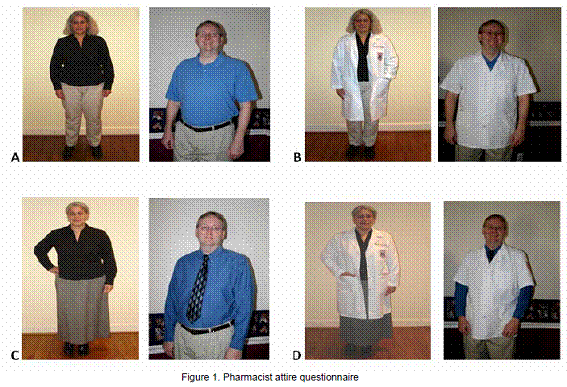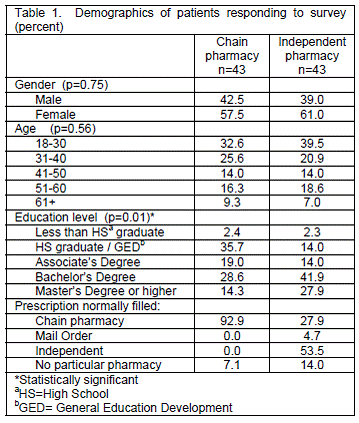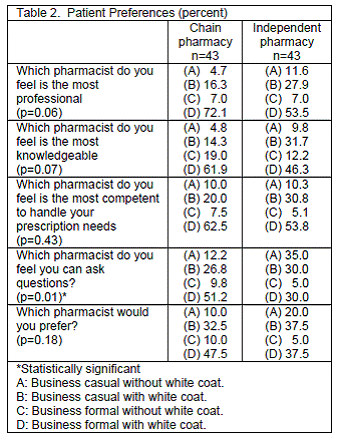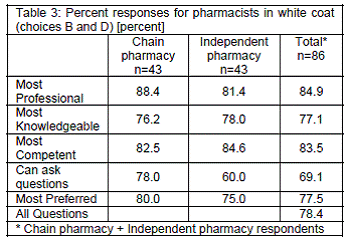Meu SciELO
Serviços Personalizados
Journal
Artigo
Indicadores
-
 Citado por SciELO
Citado por SciELO -
 Acessos
Acessos
Links relacionados
-
 Citado por Google
Citado por Google -
 Similares em
SciELO
Similares em
SciELO -
 Similares em Google
Similares em Google
Compartilhar
Pharmacy Practice (Granada)
versão On-line ISSN 1886-3655versão impressa ISSN 1885-642X
Pharmacy Pract (Granada) vol.9 no.2 Redondela Abr./Jun. 2011
ORIGINAL RESEARCH
Pharmacist attire and its impact on patient preference
Vestimenta del farmacéutico y su impacto en las preferencias de los pacientes
Erika Cretton-Scott1, Leah Johnson2, Sean King3
1. PhD. Assistant Professor. Department of Pharmaceutical, Social, and Administrative Sciences. McWhorter School of Pharmacology. Birmingham, Alabama (United States).
2. PharmD. Pharmacy Manager. Wal-Mart Pharmacy (1100). Hamilton, Alabama (United States).
3. PhD. Assistant Professor. Department of Pharmaceutical Sciences, Union University School of Pharmacy, Jackson, Tennessee (United States).
ABSTRACT
Objective: To determine the influence of demographics on patient preferences for community pharmacist attire.
Methods: A 10-item questionnaire was developed and administered to patients visiting a chain pharmacy or an independent pharmacy in the Birmingham, Alabama metropolitan area. Mann-Whitney was used to examine if statistical differences existed in chain versus independent pharmacy patient´s selections based on pharmacist attire.
Results: A statistically significant difference in patient preference for pharmacist attire between the settings in regards to which pharmacist patients felt was more approachable was observed; 51.2% of chain pharmacy respondents compared to 30% of independent pharmacy respondents identified the pharmacist pair with business formal attire and white coat as more approachable. Differences in education was also apparent with 70% of respondents in the independent pharmacy setting reporting having a Bachelor´s degree or higher compared to 45% of respondents in the chain pharmacy setting.
Conclusion: With the exception of approachability, patients indicated preference for pharmacist with the white coat regardless of community setting. Given the importance of patient-pharmacist communication for building successful patient-pharmacist relationships, if patients do not perceive the pharmacists as approachable, communication and subsequent development of said relationships may not occur regardless of perceived knowledge and competency.
Key words: Clothing. Professional-Patient Relations. Pharmacists. United States.
RESUMEN
Objetivo: Determinar la influencia de la demografía en las preferencias de los pacientes por la vestimenta de los farmacéuticos comunitarios.
Métodos: Se desarrolló y administró un cuestionario de 10 preguntas a pacientes que visitan una farmacia comunitaria de cadena y una independiente en el área metropolitana de Birmingham, Alabama. Se usó el test de Mann-Whitney para determinar si existen diferencias entre las farmacias de cadena e independientes en la selección de los pacientes de la vestimenta de los farmacéuticos.
Resultados: Se observó una diferencia significativa en las preferencias de los pacientes en los dos tipos de establecimientos en relación a que farmacéutico sentían más próximo: 51,2% de los respondentes de cadenas comparado con el 30% de los de farmacias independientes identifico al par de farmacéuticos con vestimenta formal de empresa y bata blanca como más próximo. Las diferencias en educación también fueron aparentes, con un 70% de los respondentes en farmacia independiente con una licenciatura o superior, comparado con el 45% de los respondentes en farmacias de cadena.
Conclusión: Con excepción de la proximidad, los pacientes indicaron su preferencia por farmacéuticos con bata blanca independientemente del tipo de establecimiento. Dada la importancia de la comunicación paciente-farmacéutico para construir una relación exitosa, si los pacientes no perciben al farmacéutico como próximo, la comunicación y el consiguiente desarrollo de la citada relación puede no ocurrir, independientemente de los conocimientos y competencia percibidos.
Palabras clave: Vestidos. Relaciones profesional-Paciente. Farmacéuticos. Estados Unidos.
Introduction
What is the appropriate attire for the community pharmacist? As a society, we often judge individuals with respect to credibility, approachability, knowledge, and trustworthiness based on appearance. These attributes are especially important in healthcare where patients literally place their wellbeing in the hands of healthcare professionals. It is not surprising then that proper appearance has long been held as a key component of professionalism and that appearance and dress may influence patient-professional relationships. This relationship between appropriate attire and professionalism is embraced by the pharmacy profession. Both the American Pharmacist Association (APhA) and Academy of Student Pharmacist (ASP) together with the American Association of Colleges of Pharmacy (AACP) through the Committee on Student Professionalism recommend that schools and colleges of pharmacy develop a dress code, noting that "appropriate attire is important in creating an image that is consistent with the public´s expectation of a health professional" and that "a properly attired individual creates a positive impression that can garner respects and confidence".1 The value placed on attire is also reflected in practice sites through the use of policies and evaluation criteria that include dress and appearance. Yet, current societal trends challenge the formal attire dress code, suggesting movement towards a more casually dressed work week beyond the "casual Friday." But is the casually dressed healthcare provider less professional? As this trend towards a more relaxed dress code continues, many in the healthcare profession, including pharmacy, wonder what effect, if any, this would have on the patient-healthcare provider relationship.
The significance of attire in the healthcare profession has been investigated largely in the medical profession. Most studies report that patients prefer physicians to be dressed in professional attire, with a white lab coat.2-5 It has been documented that while physician attire does not appear to affect overall satisfaction with care, the majority of patients tended to favor their physician to be dressed in more formal attire. Preference for formal attire has also been reported in dentistry7 and in nursing where studies have shown patient prefer for nurses to be dressed in white uniforms.8-10 Still, other studies report that patients have no preference for physician dress. It has also been suggested that patient preference may be linked to physician specialty. For example, patients appear to be more accepting of casually dressed psychiatrists11, and emergency room physicians.12 In a recent study assessing patient satisfaction with care among obstetricians in an outpatient setting satisfaction was not found to be influenced by attire.13 This finding may simply reflect specialty-specific differences among the patient populations and the type of patient-physician relationships formed. This is made evident by a recent study which found that while mental health patients did not have a preference for the type of attire worn by the nursing staff, wearing of identification badges was viewed as essential.14 These authors also discovered that attire did not affect patient perception of the nursing staff´s competence or professionalism.14
Less is known regarding patient preference regarding pharmacist attire. Most published studies have not examined patient preference of pharmacist attire independent of other variables. One such study found that patients placed more importance on personal attention from the pharmacist in managing their asthma than on the quality of pharmaceutical care provided by the pharmacist.15 Although these findings reinforce the importance of the pharmacist-patient interaction they say nothing of whether pharmacist attire influenced this interaction, another more recent study examining the effect of attire on patient evaluations of pharmacists found that patients viewed communication as more important than what the pharmacists were wearing.16 Though not conclusive, these findings seem to support the view that dress does not affect the patient-provider interaction. However, this study did not specifically address patient preference based on first impressions alone. It asked, would a patient´s perception of and preference for a pharmacist be influenced by attire alone in the absence of a personal interaction with the pharmacist? Given the progression of the profession towards a greater patient-centered care model of practice, the manner in which a pharmacist dresses may in fact be important for patient perception and thus could have a role in determining how to best meet the needs of patients. The purpose of this study was to investigate whether or not patients have a preferred dress for their community pharmacist and identify what patient demographics, if any, influenced such patient preferences.
Methods
A convenience sample of patients at two community pharmacies (one independent pharmacy and one chain pharmacy) located in the Birmingham, Alabama metropolitan area, was recruited to participate in an anonymous survey. Patients waiting for prescriptions were asked if they would like to participate in a 10-min survey concerning their opinions on how a pharmacist should dress. Patients volunteering to participate in the study viewed four sets of photographs (Figure 1 A-D) of the same male and female pharmacist pair. Neither of the pharmacists displayed in the photographs were employed at the participating pharmacies. The pharmacists were dressed in various attires, including: the pharmacist pair wearing business casual attire without a white coat (Picture A), the pharmacist pair wearing business casual attire with a white coat (Picture B), the pharmacist pair wearing formal business attire without a white coat (Picture C) and the pharmacist pair wearing formal business attire with a white coat (Picture D). Casual business attire for the male pharmacist consisted of khaki pants and a polo type shirt. Casual business attire for the female pharmacist consisted of khaki pants, and a dress shirt. Formal business attire for the male pharmacist consisted of dress pants, shirt and tie and for the female pharmacist a skirt and a dress shirt. After viewing the photographs, patients were asked to identify which pharmacist pair was most professional, knowledgeable, and competent, which pharmacist they could ask questions of (i.e. most approachable) and which pair they preferred overall. Respondent demographic information such as age, education and where they normally filled prescriptions was also obtained. This study was approved by the Samford University Institutional Review Board (IRB).

A descriptive analysis was performed to generate frequencies and measures of central tendency. Mann-Whitney test was used to examine if statistical differences existed in chain versus independent pharmacy patient´s selections on the survey based on pharmacist dress attire. All analyses were conducted using SPSS 16.0 (Chicago, IL) at the 0.05 level of significance.
Results
Eighty-six usable surveys, 50% from a chain pharmacy setting and 50% from an independent pharmacy setting were completed and returned from the two pharmacy settings. All surveys were usable and were included in the final analyses.
Demographics
The demographic characteristics of respondents are listed in Table 1. The majority of chain pharmacy respondents (58.2%) and of independent pharmacy respondents (60.4%) were between the ages of 18 and 40. However, respondents at the independent pharmacy were significantly more highly educated than their chain counterparts p≤0.05). Seventy percent of respondents from the independent pharmacy setting reported having a Bachelor´s degree or higher compared to 43% of respondents from the chain pharmacy setting. Almost a third (27.9%) of respondents in the independent pharmacy setting indicated that they normally fill their prescriptions at a chain pharmacy. Conversely, 92.9% of respondents in the chain pharmacy setting indicated normally filling their prescriptions at a chain pharmacy.

Patient Preferences
The main objective of this study was to determine if pharmacist attire significantly influenced patient perception of the pharmacist in regards to their professionalism, knowledge, competency and approachability. The influence of pharmacist attire on overall patient preference was also assessed. Patient preferences for community pharmacist attire in a chain pharmacy setting and in an independent pharmacy setting are summarized in Table 2. The findings revealed a significant (p≤0.05) difference in patients preferences for pharmacist attire between the chain pharmacy setting and independent pharmacy setting in regards to "which pharmacist do you feel you can ask questions?" Significantly more chain pharmacy respondents (51.2%) identified the pharmacist pair in business formal attire with white coat as the pharmacist they felt they could ask questions of ("more approachable") compared to only 30% of independent pharmacy respondents identifying this pair.

Although not statistically significant, it should be noted that mathematically more respondents in the chain pharmacy setting (72.1%) indicated that the pharmacist pair dressed in business formal attire with a white coat were the most professional as compared to respondents in the independent pharmacy setting (53.5%). Almost twice as many respondents (27.9%) in the independent pharmacy setting identified the pharmacist pair dressed in business casual attire with a white coat as most professional, compared to 16.3% of respondents in the chain pharmacy setting. Similar findings were reported in regards to pharmacist´s competency and respondent overall preference (see Table 2). Respondents at the chain pharmacy chose the pharmacist pair dressed in business formal attire with a white coat as the most knowledgeable (61.9%) followed by the pharmacist pair dressed in business formal attire without a white coat (19.1%). Respondents at the independent pharmacy also indicated that the pharmacist pair dressed in business formal attire with a white coat was the most knowledgeable (46.3%).However, unlike respondents at the chain pharmacy, almost one-third (31.7%) indicated that the pharmacist pair dressed in business casual attire with a white coat were the most knowledgeable. It is interesting to note that, overall, both groups overwhelmingly selected the pharmacist pair wearing a white coat on all questions (see Table 3).

Discussion
This investigation has elucidated the differences in patient preferences for pharmacist attire between patients in both a chain and independent pharmacy setting. It was of interest that respondents in the independent pharmacy setting were significantly higher educated than their counterparts in the chain pharmacy setting. This may relate to the location of the independent pharmacy within a medical professional building. It would be conceivable that the personnel of the medical practice may fill their prescription at the independent pharmacy due to location and thus accounting for the difference in education level between the two community settings. It was also noted that approximately one third of respondents in the independent pharmacy setting indicated normally using a chain pharmacy to fill their prescriptions. Given that respondents were not asked to explain their answers, we can only surmise that some respondents were patients of the medical practice choosing to fill their prescription at the independent pharmacy due to convenience or other factors.
The only statistically significant difference found between respondents in a chain pharmacy setting and an independent pharmacy setting in regards to pharmacist attire concerned which set of pharmacists the respondents would prefer to ask questions ("more approachable"). Patients in the independent pharmacy setting identified the casually dressed pharmacist as most approachable. However, these same respondents did not choose the casually dressed pharmacist as the most professional, competent, knowledgeable, or prefer them overall. In fact, the pharmacist pair wearing a white coat, either causally or formally dressed, was chosen most often in all questions. It is intriguing that patients frequenting the independent pharmacy preferred a pharmacist wearing a white coat. It is possible that choosing an independent pharmacy to fill prescriptions is less related to how the pharmacist is dressed and more related to other aspects of this pharmacy setting that are appealing to patients such as better opportunities for consulting with the pharmacist, obtaining prescriptions in a timely manner, having their medication in stock and availability of health programs such as diabetes management, immunizations and screenings. The J.D. Power and Associates 2010 U.S. National Pharmacy Study on consumer experiences with retail and mail order pharmacy providers bears this out as consumers gave highest ratings to independent pharmacies.17 Future studies should explore this aspect more thoroughly.
To our knowledge, this is the first study that has attempted to examine the issue of first impressions in regards to pharmacist attire and patient preference. It is interesting that the majority of respondents in both the chain and independent pharmacy setting selected the pharmacist wearing a white coat for all questions in this study. This finding is not surprising given the importance of the nonverbal aspect of communication in the health care environment, which is associated closely with patient satisfaction with care.18 It has been estimated that approximately 93% of an intended message´s meaning is derived from nonverbal components.19 The attire pharmacists chose to wear likely contributes a great deal to this percentage. Factors such as whether the clothes are in style, match, or are presentable (i.e., not wrinkled) communicate important messages to patients. Additionally, how the pharmacist differentiates him or herself from other staff members by wearing a professional coat and name badge may communicate aspects of professionalism and expertise which significantly affects the communication process.19 The present study elucidates how pharmacist´s attire may affect the patient-pharmacists relationship. These results indicate that while a pharmacist´s attire should convey a friendly and inviting message to patients, it should also convey a message of professional competence. It is impossible to deduct from this study how much of these finding are a result of patient experiences or familiarity with seeing a community pharmacist wearing a white coat or the expectation that a pharmacist should be wearing a white coat. Future studies should further explore why patients preferred seeking information from pharmacists they did not consider, based on attire, to be most professional, competent, and knowledgeable and why their overall preference was the pharmacist with a white coat, regardless of attire. As pharmacy continues to evolve toward greater patient-centered care, pharmacists and educators may want to consider how attire and perhaps work setting affects the pharmacist-patient relationship.
There are several limitations to this study. The study has a relatively small sample size and the population was drawn from only two pharmacies located in the Birmingham, AL metropolitan area. Larger studies are needed which involve more patients from more pharmacies to understand better the significance of pharmacist attire to patient populations. Participants in the present study were not asked to specify ethnicity. It is possible that culture and/or ethnicity may influence the meaning of attire. This aspect should be investigated in future studies. In addition, the independent pharmacy was located in a professional building also housing a medical office, thus it is conceivable that patients of the medical practice would occasionally choose to fill their prescription at the independent pharmacy due to location even if normally they would fill their prescriptions at a chain pharmacy. It is also possible respondent preference for pharmacist attire may reflect the fact that 1) patients are accustomed to seeing their pharmacist dressed in a particular manner and hence would likely select attire with which they are most familiar and 2) traditionally, pharmacists have worn a white coat and thus it is expected that they would, regardless of the practice setting. Finally, this study utilized a convenience sample of patients; therefore findings are not generalizable to other patients or pharmacies.
Conclusions
Although patients in the independent pharmacy setting identified the casually dressed pharmacist as more approachable than did patients in the chain pharmacy setting, patients in both settings overwhelmingly selected the pharmacist with a white coat, regardless of attire, as most professional, competent, and knowledgeable. Though not definitive, these findings suggest that, with the exception of approachability, patients prefer pharmacists to wear the white coat regardless of practice setting.
Communication between pharmacist and patients is important for building successful interpersonal relationships. If the patient does not perceive the pharmacists as approachable, communication and subsequent development of patient-pharmacist relationship may not occur regardless of perceived knowledge and competency.
Conflict of interest
There are no conflicts of interest to be disclosed.
References
1. Pharmacy Professionalism Toolkit for Students and Faculty, APhA-ASP/AACP Committee on Student Professionalism. http://www.pharmacist.com/AM/Template.cfm?Section=ProfessionalismToolkit_for_Students_and_Faculty (Accessed July 26, 2010). [ Links ]
2. Rehman SU, Nietert PJ, Cope DW, Kilpatrick AO. What to wear today? Effect of doctor's attire on the trust and confidence of patients. Am J Med. 2005;118(11):1279-1286. [ Links ]
3. Keenum AJ, Wallace LS, Stevens AR. Patients' attitudes regarding physical characteristics of family practice physicians. South Med J. 2003;96(12):1190-1194. [ Links ]
4. McNaughton-Filion L, Chen JSC, Norton PG. The physician´s appearance. Fam Med. 1991; 23:208-211. [ Links ]
5. McKinstry, B; Wang JX. Putting on the style: what patients think of the way their doctor dresses. Br J Gen Pract. 1991; 41(348):275-278. [ Links ]
6. Brant LJ. On the value of an old dress code in the new millennium. Arc Intern Med. 2003;163(11):1277-1281. [ Links ]
7. Brosky, ME; Keefer, OA; Hodges JS; Pesun IJ; Cook G. Patient perceptions of professionalism in dentistry. J Dent Educ. 2003; 67(8): 909-915. [ Links ]
8. Kucera K, Nieswiadomy R. Nursing attire: the public´s preference. Nurs Manage. 1991;22:68-70. [ Links ]
9. Page J, Lawrence PA. Attitudes towards dress codes. Nurs Manage.1992;23:48-50. [ Links ]
10. Rowland W. Patients´ perceptions of nurse uniforms. Nurs Stand.1994;8:32-36. [ Links ]
11. Rajagopalan M, Santilli M, Powell D, Murphy M, O´Brien M, Murphy J. Mental health professionals´ attire. Aust N Z J Psychiatr. 1998;32:880-883. [ Links ]
12. Li SF, Haber M. Patient attitudes toward emergency physician attire. J Emerg Med. 2005;29(1):1-3. [ Links ]
13. Fischer RL, Hansen CE, Hunter RL, Veloski JJ. Does physician attire influence patient satisfaction in an outpatient obstetrics and gynecology setting? Am J Obstet Gynecol. 2007; 196(2):186.e1-5. [ Links ]
14. Miller T; Mann N; Grim R. Clothes encounter: patient perception of nursing attire in a behavioral health unit. J Am Psych Nurs Assoc. 2010;16(3):179-183. [ Links ]
15. Ried LD, Wang F, Young H, Awiphan R. Patients' satisfaction and their perception of the pharmacist. J Am Pharm Assoc (Wash). 1999; 39(6):835-842. [ Links ]
16. Bentley JP, Stroup LJ, Wilkin NE, Bouldin AS. Patient evaluations of pharmacist performance with variations in attire and communication levels. J Am Pharm Assoc.2005;45(5):600-607. [ Links ]
17. Independent pharmacies lauded by patients in J.D. Power and Associates study. http://www.ncpanet.org/index.php/ncpa-commentary/760-independent-pharmacies-lauded-by-patients-in-jd-power-and-associates-study (Accessed January 14, 2011). [ Links ]
18. Conlee C, Olvera J. The relationships among physician nonverbal immediacy and measures of patient satisfaction with physician care. Commun Rep. 1993;6(1):25-34. [ Links ]
19. Berger BA and Diggs AD. Immediacy: how word choice and nonverbal cues affect the relationship. In: Berger BA, ed. Communication Skills for Pharmacists: Building Relationships, Improving Patient care. 3rd edition. Washington, DC: Jacobson Medical Information LLC; 2009: 183-221. Published by the American Pharmacists Association. [ Links ]
Received (first version): 27-Oct-2010
Accepted: 26-Mar-2011














